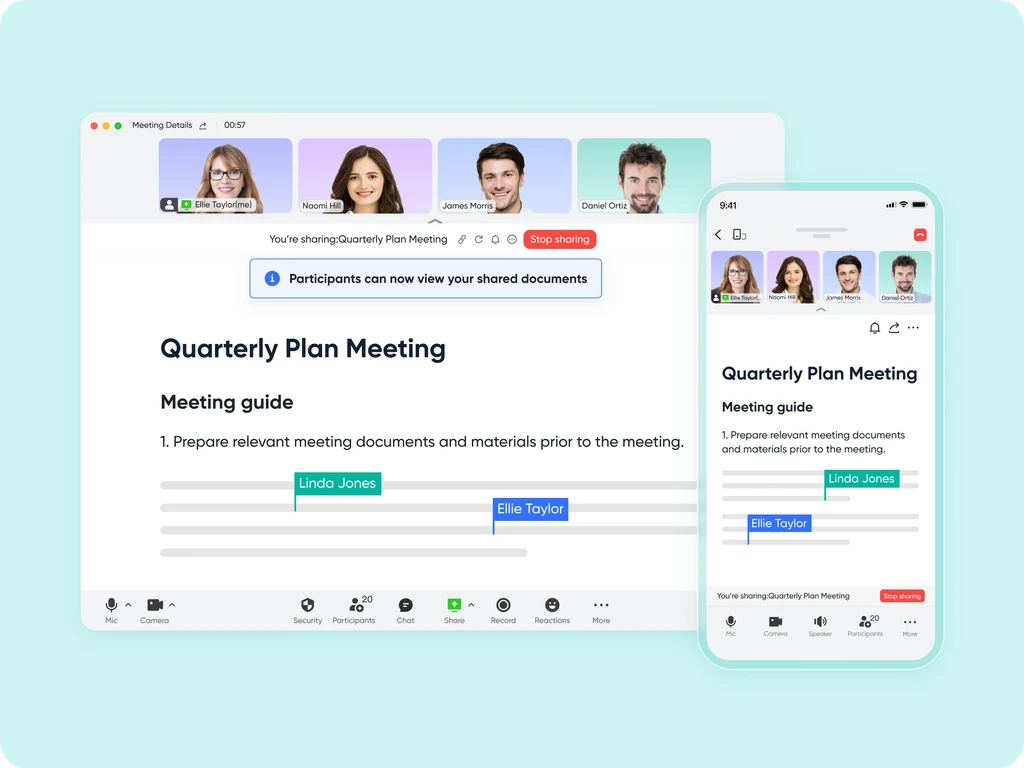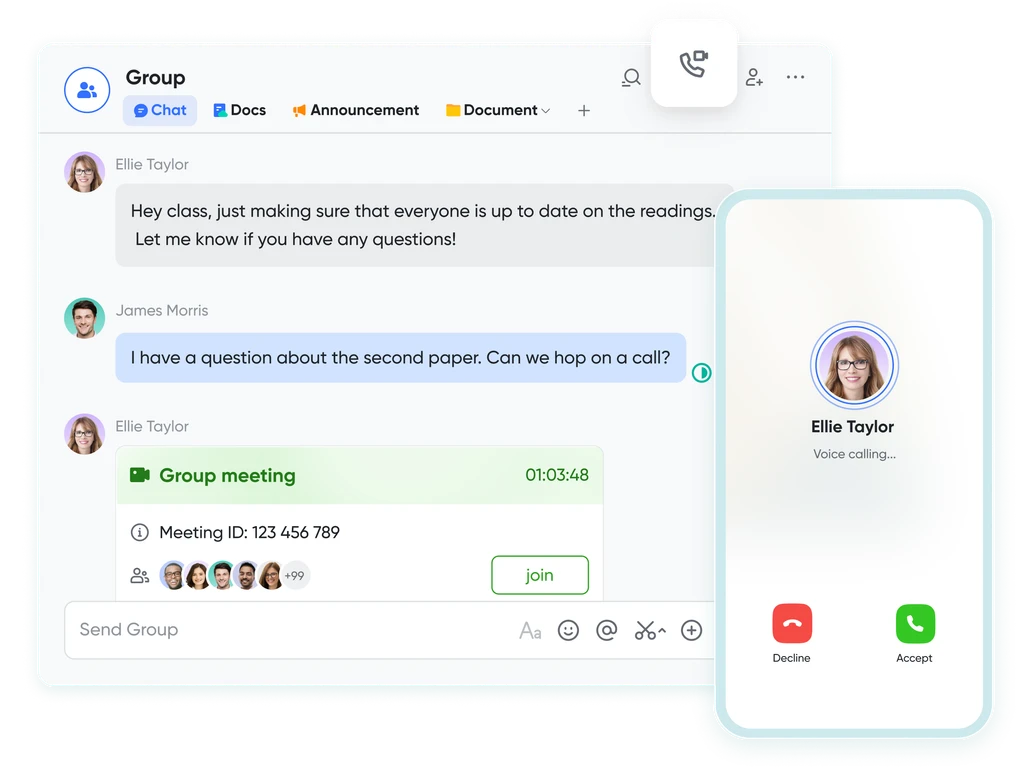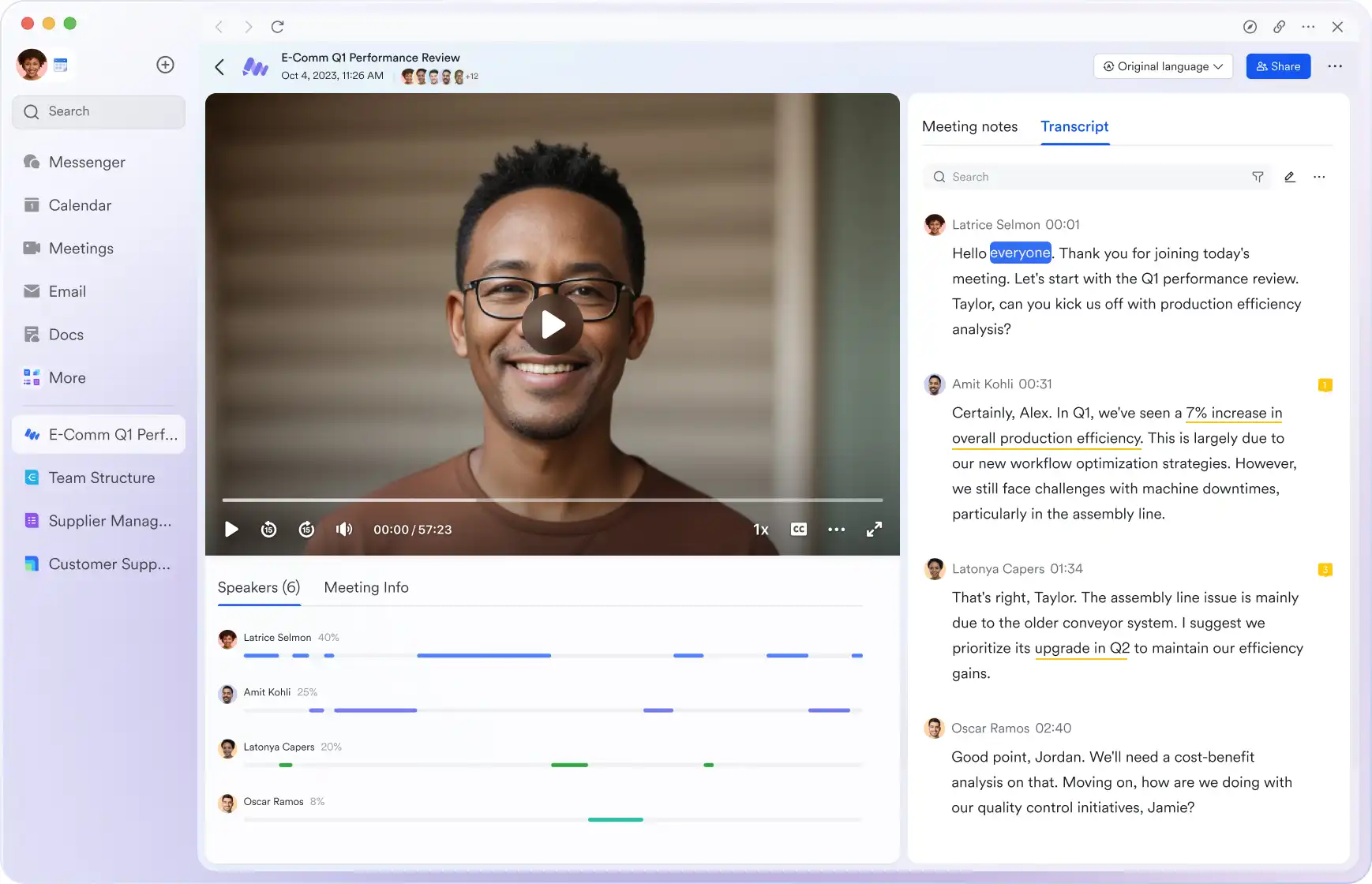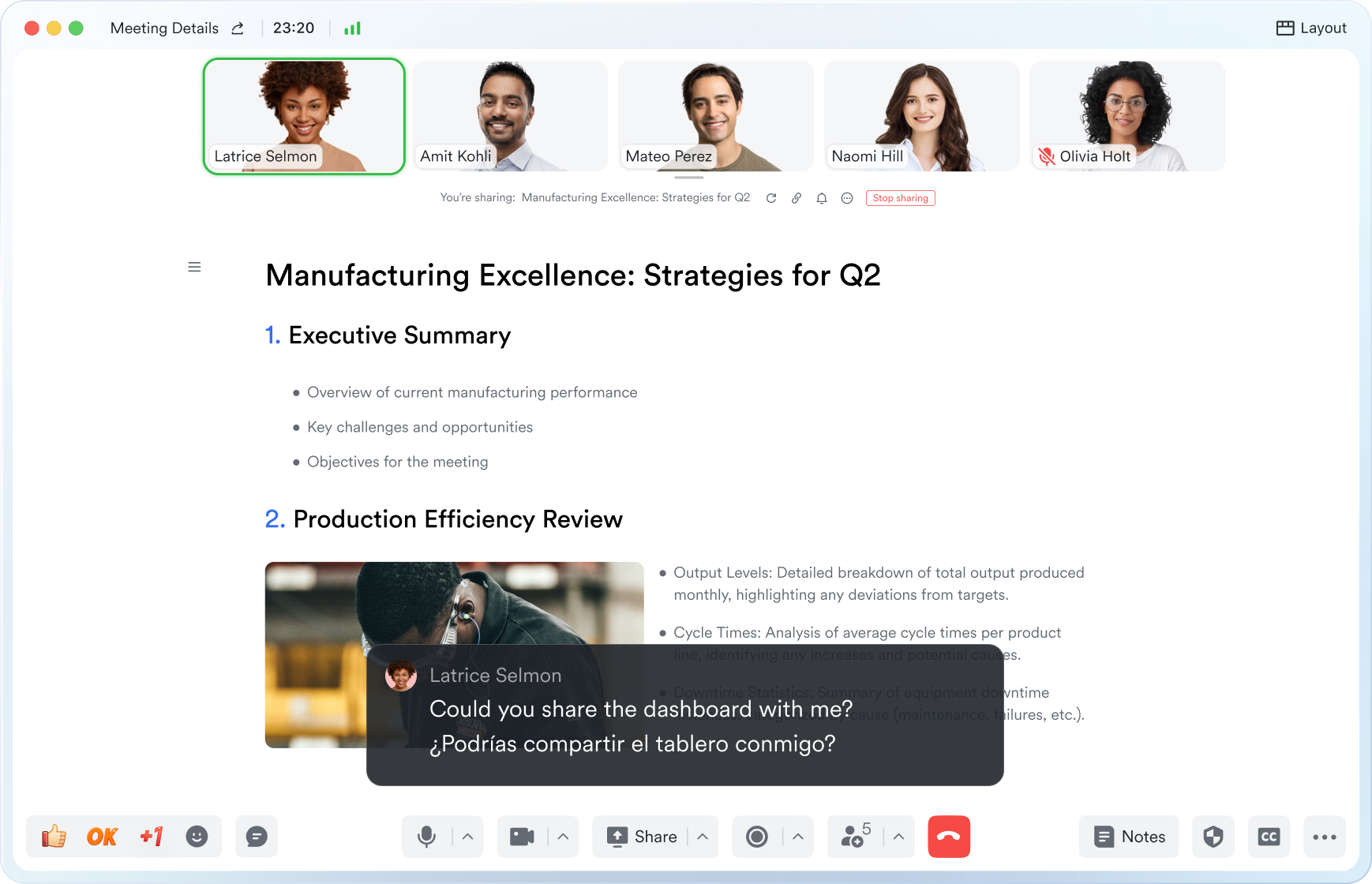New Product Development Meeting
This guide will walk you through the essential elements of use new product development meeting to keep your attendees aligned and engaged.
Try Lark for Free
As businesses continue to adapt to the ever-evolving market landscape, the importance of successful new product development meetings remains paramount. In 2024, the essence of these gatherings transcends traditional problem-solving and brainstorming, shaping the innovative capacity and competitiveness of organizations. This strategic guide aims to provide comprehensive insights and best practices for orchestrating successful new product development meetings, equipping leaders, and stakeholders with the tools needed to drive sustainable growth and product excellence.
Use Lark Meetings to turn meetings into true collaborative experiences.
What is a new product development meeting?
A new product development meeting is a structured assembly of key stakeholders and cross-functional teams aimed at strategizing, planning, and executing initiatives related to the conception, development, and launch of new products or product enhancements. These gatherings serve as the nucleus for aligning diverse perspectives, leveraging expertise, and establishing a unified roadmap for product innovation. In essence, the meeting acts as a catalyst for transforming ideas into actionable plans that fuel the growth and evolution of products in an organization's portfolio.
Goals of new product development meeting
The overarching goals of a new product development meeting revolve around driving innovation, fostering collaboration, and steering the product development lifecycle towards success. Among the primary objectives are:
- Idea Cultivation: Cultivating and refining innovative concepts through collaborative ideation sessions.
- Alignment and Decision-Making: Aligning stakeholders and making crucial decisions to propel the product development process forward.
- Risk Mitigation: Identifying and mitigating risks associated with product innovation and development.
- Cross-Functional Collaboration: Facilitating effective collaboration among diverse teams to ensure a well-rounded approach to product development.
Who should attend new product development meeting?
In the context of new product development, the indispensability of involving an array of stakeholders and experts cannot be overstated. Key participants in a successful new product development meeting include:
- Product Managers: Providing strategic direction and insights into market trends and customer needs.
- Engineers and Designers: Contributing technical expertise and design considerations essential to product development.
- Marketing and Sales Teams: Offering valuable market insights, competitive analysis, and go-to-market strategies.
- Finance and Legal Representatives: Providing vital input on financial viability, regulatory compliance, and risk management.
- Executive Leadership: Offering strategic guidance, decision-making, and aligning the initiative with broader business goals.
Learn more about Lark x Meetings
Topics, agenda, and structure of new product development meeting
The effectiveness of a new product development meeting hinges on the inclusivity of pertinent topics and a well-designed agenda. The meeting's structure is vital for ensuring the comprehensive coverage of all critical aspects. Key topics, agenda items, and structural considerations encompass:
- Idea Generation and Evaluation: Dedicate time for brainstorming and evaluating product ideas to promote innovation.
- Market Analysis and Customer Insights: Delve into market research, competitive landscape, and customer insights to inform product development strategies.
- Technical Feasibility and Prototyping: Discuss the technical feasibility of product ideas and the potential for prototyping.
- Risk Assessment and Mitigation: Address potential risks and devise contingency plans to mitigate them.
- Decision-Making and Roadmapping: Allocate time for decisive discussions and consensus-building to formulate a clear product roadmap.
Learn more about Lark x Meetings
How often does a new product development meeting occur?
The frequency of new product development meetings heavily hinges on the organization's product development cycle, the pace of innovation, and the magnitude of product pipeline activities. These meetings may occur monthly, quarterly, or as needed based on the urgency and scope of new product initiatives. In agile environments, continuous feedback loops and iterative development may necessitate more frequent meetings, while well-defined, long-term projects may require less frequent gatherings.
Key differences between new product development meeting and another similar meeting
In contrast to standard status meetings or brainstorming sessions, new product development meetings are distinct due to their emphasis on strategic planning, decision-making, and the convergence of multifaceted expertise. These differences manifest in the following ways:
- Strategic Focus: New product development meetings align with the strategic vision of the organization, focusing on long-term product outcomes rather than routine updates.
- Decision-Centric: Unlike brainstorming sessions, these meetings prioritize decision-making, encompassing critical evaluations and go/no-go decisions for new product initiatives.
- Cross-Functional Inclusivity: Unique to these meetings is the comprehensive representation of cross-functional teams, ensuring a holistic and well-informed approach to product development.
Learn more about Lark x Meetings
Three practical examples of new product development meeting
Example 1: successful implementation of new product features
Example 1: successful implementation of new product features
In a real-world scenario, a new product development meeting resulted in the successful implementation of innovative features in an existing product. Through collaborative discussions, engineering, product management, and marketing teams deliberated and agreed on the incorporation of cutting-edge functionalities, enhancing the product's value proposition and market competitiveness.
Example 2: new market entry strategy
Example 2: new market entry strategy
A new product development meeting played a pivotal role in formulating a successful market entry strategy for a product extension. Through market analysis, cross-functional dialogue, and strategic planning, the meeting culminated in a well-defined roadmap for penetrating a new market segment, ensuring a swift and impactful market entry.
Example 3: streamlined product development process
Example 3: streamlined product development process
In a progressive organization, a new product development meeting transformed the product development process. By fostering collaboration between engineering and design teams, the meeting sparked innovative ideation, leading to a streamlined and efficient product development process, ultimately accelerating time-to-market and enhancing overall operational efficiency.
Common pitfalls of a new product development meeting
Despite their significance, new product development meetings may encounter common pitfalls that hinder their effectiveness. These include:
- Lack of Clear Objectives: Meetings lacking well-defined goals and objectives may result in prolonged discussions and unclear outcomes.
- Inadequate Preparation: Insufficient pre-meeting preparation can lead to uninformed discussions and limited productivity.
- Limited Stakeholder Involvement: Inadequate representation of relevant stakeholders may hinder comprehensive decision-making and ideation.
- Overwhelming Agenda: Overloading the agenda with excessive topics may lead to superficial discussions and a lack of focus. To mitigate these pitfalls, proactive measures such as focused agenda setting, comprehensive pre-meeting preparation, and inclusive stakeholder involvement are imperative.
Learn more about Lark x Meetings
Dos and don’ts of a new product development meeting
| Dos | Don'ts |
|---|---|
| Encourage Diverse Perspectives: Embrace diverse viewpoints to foster holistic decision-making. | Avoid Dominant Personalities: Discourage the dominance of individuals to ensure balanced participation. |
| Set Clear Objectives: Define clear meeting objectives to guide discussions and decision-making. | Don't Overload the Agenda: Avoid overwhelming the agenda with excessive or irrelevant topics to maintain focus. |
| Foster Collaborative Environment: Cultivate an open and collaborative atmosphere to encourage constructive dialogue. | Dismiss Dissenting Opinions: Create an environment where dissenting viewpoints are neglected, stifling innovation. |
What makes a virtual new product development meeting successful?
Virtual new product development meetings demand a unique set of strategies and best practices to ensure their success. Key factors include:
- Technology-Enabled Collaboration: Leveraging advanced collaboration tools and platforms to facilitate seamless virtual interactions.
- Structured Facilitation: Implementing structured facilitation techniques to maintain engagement and focus in virtual settings.
- Pre-Meeting Technical Checks: Ensuring all participants have access to required technology and conducting technical checks before the meeting.
- Enhanced Documentation: Prioritizing detailed documentation and post-meeting summaries to compensate for the limitations of virtual interaction.
Related:
Unlock the Power of Webinars: A Comprehensive Guide to Boost Your Business | Lark Blog | Lark BlogLearn more about Lark x Meetings
Typical takeaways of the new product development meeting
A successful new product development meeting typically yields several key takeaways including:
- Decisive Action Items: Clear, actionable tasks and decisions that drive the product development process forward.
- Innovative Insights: Novel perspectives and market insights that shape the product innovation cycle.
- Aligned Roadmap: A unified roadmap for product development with the alignment of diverse stakeholder perspectives.
- Enhanced Collaboration: Strengthened collaboration and cross-functional synergy among teams involved in product development initiatives.
Questions to ask in the new product development meeting
During a new product development meeting, several pertinent questions can guide discussions and decision-making, such as:
- What are the emerging market trends that could influence our product development strategy?
- How might we mitigate potential risks associated with the proposed product enhancements?
- What are the technical considerations and feasibility of implementing the proposed product changes?
- Are our current go-to-market strategies aligned with the innovative components under consideration?
- What are the anticipated impacts on our existing product portfolio, and how might we manage potential interdependencies?
Learn more about Lark x Meetings
Conclusion
In 2024, the success of new product development meetings is pivotal in propelling organizations towards sustainable growth, innovation, and competitive advantage. By adhering to best practices, fostering inclusive collaboration, and leveraging innovative strategies, businesses can navigate the complexities of product development with confidence, agility, and clarity.
Related:
Master the Art of Meeting Notes with Lark for Enhanced Collaboration | Lark Blog | Lark BlogLearn more about Lark x Meetings
Use Lark Meetings to turn meetings into true collaborative experiences.
A Game Changer for New Product Development Meeting: Empower your team with Lark Meetings
In the fast-paced and dynamic world of modern business, effective communication and collaboration are crucial for success of New Product Development Meeting. Here we introduce Lark Meetings to serve as a centralized hub for all communication needs.
Transform your meetings into collaborative endeavors

Leverage the potency of in-call document sharing, intelligent meeting minutes, and mobile-optimized features to enhance productivity collaboratively, irrespective of your location or schedule.
Seamlessly collaborate in real-time, across any device

Share live documents instead of just screen views. Participants can navigate and edit simultaneously within the video call window, even while on the move.
Shift your focus to engagement, not note-taking

Lark Minutes automatically converts video meetings into transcripts, facilitating easy viewing, searching, and collaborative editing. Stay in the loop asynchronously, even if you can't attend the live meeting. Lark Minutes for meeting minutes support translation into 10+ different languages.
Break language barriers in communication

Lark Meetings provide real-time translation for subtitles, allowing individuals from diverse backgrounds to express themselves in their native languages. Ensure every voice is heard, regardless of geographical location. Live subtitles currently support translations from English, Chinese, and Japanese to 10+ different languages. See more translation feature in Lark.
Connect with larger audiences
Host dynamic online meetings and events accommodating up to 1,000 participants, with the flexibility of up to 50 breakout sessions for intimate group discussions within the larger meeting context. Try more Lark features for free.








